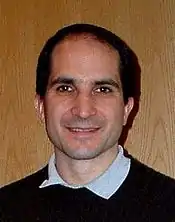Juan Martín Maldacena
Juan Martín Maldacena (September 10, 1968 in Buenos Aires, Argentina) is a theoretical physicist and the Carl P. Feinberg Professor in the School of Natural Sciences at the Institute for Advanced Study.[1] He has made significant contributions to the foundations of string theory and quantum gravity. His most famous discovery is the AdS/CFT correspondence, a realization of the holographic principle in string theory.
Juan Maldacena | |
|---|---|
 | |
| Born | September 10, 1968 |
| Nationality | Argentine, American |
| Alma mater | Universidad Nacional de Cuyo, Princeton University |
| Known for | AdS/CFT correspondence ER=EPR ABJM superconformal field theory |
| Awards | Dirac Medal Pomeranchuk Prize Fundamental Physics Prize Lorentz Medal Albert Einstein Medal |
| Scientific career | |
| Fields | Theoretical physics |
| Institutions | Institute for Advanced Study |
| Doctoral advisor | Curtis Callan |
Biography
Maldacena obtained his licenciatura (a 6-year degree) in 1991 at the Instituto Balseiro, Bariloche, Argentina, under the supervision of Gerardo Aldazábal. He then obtained his Ph.D. in physics at Princeton University after completing a doctoral dissertation titled "Black holes in string theory" under the supervision of Curtis Callan in 1996, and went on to a post-doctoral position at Rutgers University. In 1997, he joined Harvard University as associate professor, being quickly promoted to Professor of Physics in 1999. Since 2001 he has been a professor at the Institute for Advanced Study in Princeton, New Jersey and in 2016 became the first Carl P. Feinberg Professor of Theoretical Physics in the Institute's School of Natural Sciences.
Contributions to physics
Maldacena has made numerous discoveries in theoretical physics. Leonard Susskind called him "perhaps the greatest physicist of his generation... certainly the greatest theoretical physicist of his generation".[2] His most famous discovery is the most reliable realization of the holographic principle – namely the AdS/CFT correspondence, a conjecture about the equivalence of string theory on Anti-de Sitter (AdS) space, and a conformal field theory defined on the boundary of the AdS space.[3] According to the conjecture, certain theories of quantum gravity are equivalent to other quantum mechanical theories (with no gravitational force) in one fewer spacetime dimensions.
In subsequent works, Maldacena elucidated several aspects of the AdS/CFT correspondence, describing how certain physical observables defined in one theory can be described in the equivalent theory. Shortly after his original work on the AdS/CFT correspondence, Maldacena showed how Wilson lines can be computed in a corresponding string theory by considering the area swept by an evolving fundamental string.[4] Wilson lines are non-local physical observables defined in gauge theory. In 2001, Maldacena proposed that an eternal black hole, an object defined in a gravitational theory, is equivalent to a certain entangled state involving two copies of the corresponding quantum mechanical theory.[5] Ordinary black holes emit Hawking radiation and eventually evaporate. An eternal black hole is a type of black hole that survives forever because it eventually re-absorbs the radiation it emits.
In 2013, Maldacena co-authored an analysis of the 2012 black hole firewall paradox with Leonard Susskind, arguing that the paradox can be resolved if entangled particles are connected by minor wormholes."[6][7][8]
Awards
Maldacena has received these awards:
- Alfred P. Sloan Foundation Fellowship, 1998
- Packard Fellowship in Science and Engineering, 1998
- MacArthur Fellowship, 1999[9]
- UNESCO Husein Prize for Young Scientists, 1999
- Sackler Prize in Physics, 2000
- Xanthopoulos International Award for Research in Gravitational Physics,[10] 2001
- Pius XI Medal, 2002
- Edward A. Bouchet Award[11] of the American Physical Society, 2004
- Member of the American Academy of Arts and Sciences, elected 2007[12]
- Member of the National Academy of Sciences, elected 2013[13]
- Dannie Heineman Prize, 2007[14]
- Dirac Medal of the ITCP, 2008
- Pomeranchuk Prize, 2012
- Fundamental Physics Prize, 2012.[15]
- Diamond Konex Award as the most important scientist in the last decade in Argentina, 2013
- Lorentz Medal, 2018 [16]
- Albert Einstein Medal, 2018[17]
- St. Albert Award, 2018[18]
- Galileo Galilei Medal, 2019
References
- "Juan Maldacena". Institute for Advanced Study. Retrieved 2020-05-13.
- Susskind, Leonard (April 30, 2014). Black Holes, the Conservation of Information, and the Holographic Principle (Speech). Messenger Lectures on "The Birth of the Universe and the Origin of Laws of Physics". Cornell University. 68 minutes in.
- Juan Martin Maldacena (1998). "The Large N Limit of Superconformal Field Theories and Supergravity". Adv. Theor. Math. Phys. 2 (2): 231–252. arXiv:hep-th/9711200. Bibcode:1998AdTMP...2..231M. doi:10.4310/atmp.1998.v2.n2.a1.
- Maldacena, Juan M. (1998-06-01). "Wilson loops in large N field theories". Physical Review Letters. 80 (22): 4859–4862. arXiv:hep-th/9803002. doi:10.1103/PhysRevLett.80.4859. ISSN 0031-9007.
- Maldacena, Juan M. (2003-04-12). "Eternal Black Holes in AdS". Journal of High Energy Physics. 2003 (4): 021. arXiv:hep-th/0106112. doi:10.1088/1126-6708/2003/04/021. ISSN 1029-8479.
- Overbye, Dennis (12 August 2013). "A Black Hole Mystery Wrapped in a Firewall Paradox". New York Times. Retrieved 29 October 2013.
- "The Firewall Paradox". New York Times. 12 August 2013. Retrieved 29 October 2013.
- Cool horizons for entangled black holes
- "Meet the 1999 MacArthur Fellows". Retrieved 2013-11-25.
- "Xanthopoulos International Award for research on Gravitational Physics".
- "2004 Edward A. Bouchet Award Recipient: Juan M. Maldacena". Retrieved 2011-08-24.
- "Juan Martin Maldacena". American Academy of Arts & Sciences. Retrieved 2020-05-13.
- "Juan Maldacena". www.nasonline.org. Retrieved 2020-05-13.
- "2007 Dannie Heineman Prize for Mathematical Physics Recipient: Juan Maldacena, Institute for Advance Study". American Physical Society. Retrieved August 3, 2018.
- New annual US$3 million Fundamental Physics Prize recognizes transformative advances in the field Archived 2012-08-03 at the Wayback Machine, FPP, accessed 1 August 2012
- "LORENTZ MEDAL AWARDED TO PHYSICIST JUAN MARTÍN MALDACENA". Royal Netherlands Academy of Arts and Sciences. March 27, 2018. Retrieved August 3, 2018.
- https://www.ias.edu/news/juan-maldacena-receives-2018-einstein-medal-albert-einstein-society
- https://www.catholicscientists.org/about/St.-Albert-Award/Maldacena-bio